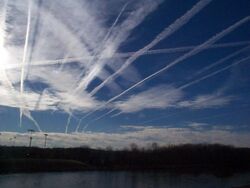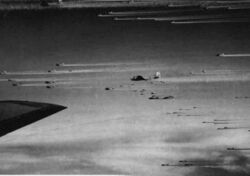Contrail
Topic: Physics
 From HandWiki - Reading time: 11 min
From HandWiki - Reading time: 11 min
| Contrails | |
|---|---|
| File:Jet-contrails-tokyosky-japan-2018.webm A jet forming contrails in a blue sky | |
| Genus | Cirrus (curl of hair), cirrocumulus, or cirrostratus |
| Altitude | 7,500 to 12,000 m (25,000 to 40,000 ft) |
| Classification | Family A (High-level) |
| Appearance | Long bands |
| Precipitation cloud? | No |
Contrails (/ˈkɒntreɪlz/; short for "condensation trails") or vapor trails are line-shaped clouds produced by aircraft engine exhaust or changes in air pressure, typically at aircraft cruising altitudes several miles above the Earth's surface. They are composed primarily of water, in the form of ice crystals. The combination of water vapor in aircraft engine exhaust and the low ambient temperatures at high altitudes causes the trails' formation. Impurities in the engine exhaust from the fuel, including sulfur compounds (0.05% by weight in jet fuel) provide some of the particles that serve as nucleation sites for water droplet growth in the exhaust. If water droplets form, they can freeze to form ice particles that compose a contrail.[1] Their formation can also be triggered by changes in air pressure in wingtip vortices, or in the air over the entire wing surface.[2] Contrails, and other clouds caused directly by human activity, are called homogenitus.[3]
Depending on the temperature and humidity at the altitude where the contrails form, they may be visible for only a few seconds or minutes, or may persist for hours and spread to be several miles wide, eventually resembling natural cirrus or altocumulus clouds.[1] Persistent contrails are of particular interest to scientists because they increase the cloudiness of the atmosphere.[1] The resulting cloud forms are formally described as homomutatus,[3] and may resemble cirrus, cirrocumulus, or cirrostratus, and are sometimes called cirrus aviaticus.[4] Some persistent spreading contrails contribute to climate change.[5]
Condensation trails as a result of engine exhaust

Engine exhaust is predominantly made up of water and carbon dioxide, the combustion products of hydrocarbon fuels. Many other chemical byproducts of incomplete hydrocarbon fuel combustion, including volatile organic compounds, inorganic gases, polycyclic aromatic hydrocarbons, oxygenated organics, alcohols, ozone and particles of soot have been observed at lower concentrations. The exact quality is a function of engine type and basic combustion engine function, with up to 30% of aircraft exhaust being unburned fuel.[6] (Micron-sized metallic particles resulting from engine wear have also been detected.) At high altitudes as this water vapor emerges into a cold environment, the localized increase in water vapor can raise the relative humidity of the air past saturation point. The vapor then condenses into tiny water droplets which freeze if the temperature is low enough. These millions of tiny water droplets and/or ice crystals form the contrails. The time taken for the vapor to cool enough to condense accounts for the contrail forming some distance behind the aircraft. At high altitudes, supercooled water vapor requires a trigger to encourage deposition or condensation. The exhaust particles in the aircraft's exhaust act as this trigger, causing the trapped vapor to condense rapidly. Exhaust contrails usually form at high altitudes; usually above 8,000 m (26,000 ft), where the air temperature is below −36.5 °C (−34 °F). They can also form closer to the ground when the air is cold and moist.[7]
A 2013–2014 study jointly supported by NASA, the German aerospace center DLR, and Canada's National Research Council NRC, determined that biofuels could reduce contrail generation. This reduction was explained by demonstrating that biofuels produce fewer soot particles, which are the nuclei around which the ice crystals form. The tests were performed by flying a DC-8 at cruising altitude with a sample-gathering aircraft flying in trail. In these samples, the contrail-producing soot particle count was reduced by 50 to 70 percent, using a 50% blend of conventional Jet A1 fuel and HEFA (hydroprocessed esters and fatty acids) biofuel produced from camelina.[8][9][10]
Condensation from decreases in pressure
As a wing generates lift, it causes a vortex to form at the wingtip, and at the tip of the flap when deployed (wingtips and flap-boundaries are discontinuities in airflow.) These wingtip vortices persist in the atmosphere long after the aircraft has passed. The reduction in pressure and temperature across each vortex can cause water to condense and make the cores of the wingtip vortices visible. This effect is more common on humid days. Wingtip vortices can sometimes be seen behind the wing flaps of airliners during takeoff and landing, and during landing of the Space Shuttle.
The visible cores of wingtip vortices contrast with the other major type of contrails which are caused by the combustion of fuel. Contrails produced from jet engine exhaust are seen at high altitude, directly behind each engine. By contrast, the visible cores of wingtip vortices are usually seen only at low altitude where the aircraft is travelling slowly after takeoff or before landing, and where the ambient humidity is higher. They trail behind the wingtips and wing flaps rather than behind the engines.
At high-thrust settings the fan blades at the intake of a turbofan engine reach transonic speeds, causing a sudden drop in air pressure. This creates the condensation fog (inside the intake) which is often observed by air travelers during takeoff.
The tips of rotating surfaces (such as propellers and rotors) sometimes produce visible contrails.[11]
In firearms, a vapor trail is sometimes observed when firing under rare conditions due to changes in air pressure around the bullet.[12][13] A vapor trail from a bullet is observable from any direction.[12] Vapor trail should not be confused with bullet trace, which is a much more common phenomenon (and is usually only observable directly from behind the shooter).[12][14]
Impacts on climate

In general, aircraft contrails are believed to trap outgoing longwave radiation emitted by the Earth and atmosphere more than they reflect incoming solar radiation, resulting in a net increase in radiative forcing. In 1992, this warming effect was estimated between 3.5 mW/m2 and 17 mW/m2.[15] In 2009, its 2005 value has been estimated at 12 mW/m2, based on the reanalysis data, climate models, and radiative transfer codes;, with an uncertainty range of 5 to 26 mW/m2, and with a low level of scientific understanding.[16]
Contrail cirrus may be air traffic's largest radiative forcing component, larger than all CO
2 accumulated from aviation, and could triple from a 2006 baseline to 160–180 mW/m2 by 2050 without intervention.[17][18] For comparison, the total radiative forcing from human activities amounted to 2.72 W/m2 (with a range between 1.96 and 3.48W/m2) in 2019, and the increase from 2011 to 2019 alone amounted to 0.34W/m2.[19] Contrail effects differ a lot depending on when they are formed, as they decrease the daytime temperature and increase the nighttime temperature, reducing their difference.[20] In 2006, it was estimated that night flights contribute 60 to 80% of contrail radiative forcing while accounting for 25% of daily air traffic, and winter flights contribute half of the annual mean radiative forcing while accounting for 22% of annual air traffic.[21]
Starting from the 1990s, it was suggested that contrails during daytime have a strong cooling effect, and when combined with the warming from night-time flights, this would lead to a substantial diurnal temperature variation (the difference in the day's highs and lows at a fixed station).[22] When no commercial aircraft flew across the USA following the September 11 attacks, the diurnal temperature variation was widened by 1.1 °C (2.0 °F).[23] Measured across 4,000 weather stations in the continental United States, this increase was the largest recorded in 30 years.[23] Without contrails, the local diurnal temperature range was 1 °C (1.8 °F) higher than immediately before.[24] In the southern US, the difference was diminished by about 3.3 °C (6 °F), and by 2.8 °C (5 °F) in the US midwest.[25][26] However, follow-up studies found that a natural change in cloud cover can more than explain these findings.[27] The authors of a 2008 study wrote, "The variations in high cloud cover, including contrails and contrail-induced cirrus clouds, contribute weakly to the changes in the diurnal temperature range, which is governed primarily by lower altitude clouds, winds, and humidity."[28]
In 2011, there has been a study of British meteorological records taken during World War II, which had identified one event where the temperature was 0.8 °C (1.4 °F) higher than the day's average near airbases used by USAAF strategic bombers after they flew in a formation. However, its authors cautioned that this was a single event, making it difficult to draw firm conclusions from it.[29][30][31] Then, the global response to the 2020 coronavirus pandemic led to a reduction in global air traffic of nearly 70% relative to 2019. Thus, it provided an extended opportunity to study the impact of contrails on regional and global temperature. Multiple studies found "no significant response of diurnal surface air temperature range" as the result of contrail changes, and either "no net significant global ERF" (effective radiative forcing) or a very small warming effect.[32][33][34]
Head-on contrails
A contrail from an airplane flying towards the observer can appear to be generated by an object moving vertically.[35][36] On 8 November 2010 in the US state of California , a contrail of this type gained media attention as a "mystery missile" that could not be explained by U.S. military and aviation authorities,[37] and its explanation as a contrail[35][36][38][39] took more than 24 hours to become accepted by U.S. media and military institutions.[40]
Distrails
Where an aircraft passes through a cloud, it can disperse the cloud in its path. This is known as a distrail (short for "dissipation trail"). The plane's warm engine exhaust and enhanced vertical mixing in the aircraft's wake can cause existing cloud droplets to evaporate. If the cloud is sufficiently thin, such processes can yield a cloud-free corridor in an otherwise solid cloud layer.[41] An early satellite observation of distrails that most likely were elongated, aircraft-induced fallstreak holes appeared in Corfidi and Brandli (1986).[42]
Clouds form when invisible water vapor (H
2O in gas phase) condenses into microscopic water droplets (H
2O in liquid phase) or into microscopic ice crystals (H
2O in solid phase). This may happen when air with a high proportion of gaseous water cools. A distrail forms when the heat of engine exhaust evaporates the liquid water droplets in a cloud, turning them back into invisible, gaseous water vapor. Distrails also may arise as a result of enhanced mixing (entrainment of) drier air immediately above or below a thin cloud layer following passage of an aircraft through the cloud, as shown in the second image below:
See also
- Chemtrail conspiracy theory
- Cirrus cloud
- Cloud chamber – particle detector that works on similar principle
- Environmental impact of aviation
- Fallstreak hole
- Global dimming
- Ship tracks
- Skywriting
- Space jellyfish
- Twomey effect
References
- ↑ 1.0 1.1 1.2 "Aircraft Contrails Factsheet". FAA.Gov. https://www.faa.gov/sites/faa.gov/files/regulations_policies/policy_guidance/envir_policy/contrails.pdf.
- ↑ "vapour trail". Encyclopædia Britannica. Encyclopædia Britannica Inc.. https://www.britannica.com/EBchecked/topic/623212/vapour-trail. Retrieved 17 April 2012.
- ↑ 3.0 3.1 Sutherland, Scott (23 March 2017). "Cloud Atlas leaps into 21st century with 12 new cloud types". The Weather Network. Pelmorex Media. https://www.theweathernetwork.com/news/articles/cloud-atlas-leaps-into-21st-century-with-12-new-cloud-types/80685/.
- ↑ "Cirrus Aviaticus – Cirrus – Names of Clouds". http://namesofclouds.com/cirrus/cirrus-aviaticus.html.
- ↑ Timperley, Jocelyn. "The fastest ways aviation could cut emissions" (in en). https://www.bbc.com/future/article/20210525-how-aviation-is-reducing-its-climate-emissions.
- ↑ Ritchie, Glenn; Still, Kenneth; Rossi Iii, John; Bekkedal, Marni; Bobb, Andrew; Arfsten, Darryl (2003). "Biological and health effects of exposure to kerosene-based jet fuels and performance additives". Journal of Toxicology and Environmental Health, Part B 6 (4): 357–451. doi:10.1080/10937400306473. PMID 12775519.
- ↑ "Contrail Education – FAQ". nasa.gov. http://science-edu.larc.nasa.gov/contrail-edu/faq.php.
- ↑ "The Week in Technology". Aviation Week & Space Technology: Paper published in Nature, Rich Moore & Hans Schlager, authors. 20–24 March 2017. http://aviationweek.com/technology/week-technology-march-20-24-2017.
- ↑ Sean Broderick (24 December 2017). "Biofuels Could Reduce Contrail Formation, Research Finds". https://www.ainonline.com/aviation-news/business-aviation/2017-12-24/biofuels-could-reduce-contrail-formation-research-finds.
- ↑ Richard H. Moore (15 March 2017). "Biofuel blending reduces particle emissions from aircraft engines at cruise conditions". Nature 543 (7645): 411–415. doi:10.1038/nature21420. PMID 28300096. PMC 8025803. Bibcode: 2017Natur.543..411M. https://elib.dlr.de/112943/1/Moore_et_al_Nature_2017.pdf.
- ↑ "Photos from the field". Vertical Magazine, April/May 2014, p. 39. Accessed: 8 July 2014.
- ↑ 12.0 12.1 12.2 Vapor trail and Bullet trace Sniper Country accessed 13 October 2021
- ↑ Vapor Trail vs Bullet Trace YouTube accessed 13 October 2021
- ↑ Language Lessons: TRACE Breach Bang Clear accessed 13 October 2021
- ↑ Ponater, M. (2005). "On contrail climate sensitivity". Geophysical Research Letters 32 (10): L10706. doi:10.1029/2005GL022580. Bibcode: 2005GeoRL..3210706P.
- ↑ Lee, D.S. (2009). "Aviation and global climate change in the 21st century". Atmos. Environ. 43 (22): 3520–3537. doi:10.1016/j.atmosenv.2009.04.024. PMID 32362760. PMC 7185790. Bibcode: 2009AtmEn..43.3520L. http://elib.dlr.de/59761/1/lee.pdf.
- ↑ Michael Le Page (27 June 2019). "It turns out planes are even worse for the climate than we thought". https://www.newscientist.com/article/2207886-it-turns-out-planes-are-even-worse-for-the-climate-than-we-thought/.
- ↑ Bock, Lisa; Burkhardt, Ulrike (2019). "Contrail cirrus radiative forcing for future air traffic". Atmospheric Chemistry and Physics 19 (12): 8163. doi:10.5194/acp-19-8163-2019. Bibcode: 2019ACP....19.8163B. https://acp.copernicus.org/articles/19/8163/2019/.
- ↑ IPCC, 2021: Summary for Policymakers. In: Climate Change 2021: The Physical Science Basis. Contribution of Working Group I to the Sixth Assessment Report of the Intergovernmental Panel on Climate Change [Masson-Delmotte, V., P. Zhai, A. Pirani, S.L. Connors, C. Péan, S. Berger, N. Caud, Y. Chen, L. Goldfarb, M.I. Gomis, M. Huang, K. Leitzell, E. Lonnoy, J.B.R. Matthews, T.K. Maycock, T. Waterfield, O. Yelekçi, R. Yu, and B. Zhou (eds.)]. Cambridge University Press, Cambridge, United Kingdom and New York, NY, USA, pp. 3–32, doi:10.1017/9781009157896.001.
- ↑ Bernhardt, J.; Carleton, A.M. (14 March 2015), "The impacts of long-lived jet contrail 'outbreaks' on surface station diurnal temperature range", Journal of International Climatology 35 (15): 4529–4538, doi:10.1002/joc.4303, Bibcode: 2015IJCli..35.4529B, https://rmets.onlinelibrary.wiley.com/doi/epdf/10.1002/joc.4303
- ↑ Stuber, Nicola (15 June 2006). "The importance of the diurnal and annual cycle of air traffic for contrail radiative forcing". Nature 441 (7095): 864–7. doi:10.1038/nature04877. PMID 16778887. Bibcode: 2006Natur.441..864S. https://www.nature.com/articles/nature04877.
- ↑ Perkins, Sid. (11 May 2002), "September's Science: Shutdown of airlines aided contrail studies", Science News (Science News Online), https://www.sciencenews.org/article/septembers-science-shutdown-airlines-aided-contrail-studies, retrieved 13 October 2021
- ↑ 23.0 23.1 Travis, D.J.; A. Carleton; R.G. Lauritsen (August 2002). "Contrails reduce daily temperature range". Nature 418 (6898): 601. doi:10.1038/418601a. PMID 12167846. Bibcode: 2002Natur.418..601T.
- ↑ Travis, D.J.; A.M. Carleton; R.G. Lauritsen (March 2004). "Regional Variations in U.S. Diurnal Temperature Range for the 11–14 September 2001 Aircraft Groundings: Evidence of Jet Contrail Influence on Climate". J. Clim. 17 (5): 1123. doi:10.1175/1520-0442(2004)017<1123:RVIUDT>2.0.CO;2. Bibcode: 2004JCli...17.1123T. https://journals.ametsoc.org/view/journals/clim/17/5/1520-0442_2004_017_1123_rviudt_2.0.co_2.xml.
- ↑ "Jet contrails affect surface temperatures", Science Daily, 18 June 2015, https://www.sciencedaily.com/releases/2015/06/150618122236.htm, retrieved 13 October 2021
- ↑ Travis, David J.; Carleton, Andrew M.; Lauritsen, Ryan G. (2002). "Contrails reduce daily temperature range". Nature 418 (6898): 601. doi:10.1038/418601a. PMID 12167846. Bibcode: 2002Natur.418..601T. http://facstaff.uww.edu/travisd/pdf/jetcontrailsrecentresearch.pdf.
- ↑ Kalkstein; Balling Jr. (2004). "Impact of unusually clear weather on United States daily temperature range following 9/11/2001". Climate Research 26: 1. doi:10.3354/cr026001. Bibcode: 2004ClRes..26....1K. http://www.int-res.com/abstracts/cr/v26/n1/p1-4/.
- ↑ Hong, Gang; Yang, Ping; Minnis, Patrick; Hu, Yong X.; North, Gerald (2008). "Do contrails significantly reduce daily temperature range?". Geophysical Research Letters 35 (23): L23815. doi:10.1029/2008GL036108. Bibcode: 2008GeoRL..3523815H. https://enso.larc.nasa.gov/sass/pub/journals/Hong.etal.GRL.08.pdf.
- ↑ Irfan, Umair (7 July 2011). "World War II Bomber Contrails Show How Aviation Affects Climate". scientificamerican.com (ClimateWire). http://www.scientificamerican.com/article/contrails-aviation-affects-climate/.
- ↑ Parry, Wynne (7 July 2011). "WWII Bombing Raids Altered English Weather". livescience.com. http://www.livescience.com/14944-wwii-bombing-raids-contrails-weather-climate.html.
- ↑ Ryan, A. C. (2012). "World War II contrails: A case study of aviation-induced cloudiness". International Journal of Climatology 32 (11): 1745–1753. doi:10.1002/joc.2392. Bibcode: 2012IJCli..32.1745R.
- ↑ Digby, Ruth A. R.; Gillett, Nathan P.; Monahan, Adam H.; Cole, Jason N. S. (29 September 2021). "An Observational Constraint on Aviation-Induced Cirrus From the COVID-19-Induced Flight Disruption". Geophysical Research Letters 48 (20): e2021GL095882. doi:10.1029/2021GL095882. PMID 34924638.
- ↑ Gettelman, Andrew; Chen, Chieh-Chieh; Bardeen, Charles G. (18 June 2021). "The climate impact of COVID-19-induced contrail changes". Atmospheric Chemistry and Physics 21 (12): 9405–9416. doi:10.5194/acp-21-9405-2021. https://acp.copernicus.org/articles/21/9405/2021/.
- ↑ Zhu, Jialei; Penner, Joyce E.; Garnier, Anne; Boucher, Olivier; Gao, Meng; Song, Lei; Deng, Junjun; Liu, Cong-qiang et al. (18 March 2022). "Decreased Aviation Leads to Increased Ice Crystal Number and a Positive Radiative Effect in Cirrus Clouds". AGU Advances 3 (2): ee2020GL089788. doi:10.1029/2021AV000546.
- ↑ 35.0 35.1 McKee, Maggie (9 November 2010). "Mystery 'missile' likely a jet contrail, says expert". New Scientist. https://www.newscientist.com/article/dn19704-mystery-missile-likely-a-jet-contrail-says-expert.html. Retrieved 10 November 2010.
- ↑ 36.0 36.1 West, Mick (10 November 2010). "A Problem of Perspective – New Year's Eve Contrail". http://contrailscience.com/a-problem-of-perspective-in-the-oc-new-years-eve-contrail/.
- ↑ "Pentagon Can't Explain "Missile" off California". CBS. 9 November 2010. http://www.cbsnews.com/stories/2010/11/09/national/main7037857.shtml.
- ↑ Pike, John E. (November 2010). "Mystery Missile Madness". GlobalSecurity.org. http://www.globalsecurity.org/org/news/2010/101110-contrail.htm.
- ↑ Bahneman, Liem (9 November 2010). "It was US Airways flight 808". http://blog.bahneman.com/content/it-was-us-airways-flight-808.
- ↑ "Pentagon: 'Mystery missile' was probably airplane". Mercury News/AP. 10 November 2010. http://www.mercurynews.com/news/ci_16574898.
- ↑ Distrail on Earth Science Picture of the Day
- ↑ Corfidi, Stephen; Brandli, Hank (May 1986). "GOES views aircraft distrails". National Weather Digest 11: 37–39. http://nwafiles.nwas.org/digest/papers/1986/Vol11-Issue2-May1986/Pg37-Corfidi.pdf. Retrieved 13 October 2021.
External links
- Contrail Education (archived) | NASA
- Contrails.nl: Contrails and AviationSmog | Galleys of contrails and aviation smog
- Contral Science | Reference site for debunking weird stories about contrails
- Dunning, Brian (15 February 2007). "Skeptoid #27: Chemtrails: Real or Not?". https://skeptoid.com/episodes/4027.
 |
34 views | Status: cached on July 31 2024 09:56:40
↧ Download this article as ZWI file
 KSF
KSF



